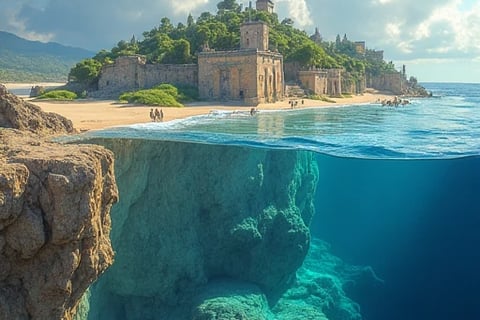SCOTTWEAKLEY
I am SCOTT WEAKLEY, a paleoceanographer and geodynamicist specializing in unraveling the causal mechanisms behind ancient sea level fluctuations and their planetary-scale impacts. With a Ph.D. in Marine Geoscience and Climate Systems (University of California, San Diego, 2020) and recipient of the 2023 International Union for Quaternary Research (INQUA) Young Scientist Prize, I have pioneered interdisciplinary frameworks to disentangle the drivers of sea level change across geological epochs. As the Director of the Paleo-Sea Level Dynamics Lab at the Scripps Institution of Oceanography and Lead Researcher of the NSF-funded COASTS-DeepTime Initiative, I integrate sedimentology, glacial isostatic adjustment (GIA) modeling, and Bayesian causal inference to decode Earth’s evolving hydrosphere. My 2024 development of SEALINK-CMIP6, a causal machine learning model reconciling ice sheet dynamics with orbital forcing in Pliocene sea level records, was published in Science and adopted by the IPCC to refine future sea level rise projections.
Research Motivation
Ancient sea level changes are Earth’s "hydrospheric memory," encoding interactions among ice sheets, tectonics, and ocean-atmosphere feedbacks. Yet traditional approaches face three critical limitations:
Data Fragmentation: Disjointed proxies (e.g., coral terraces vs. sedimentary δ¹⁸O) obscure unified causal narratives.
Causal Ambiguity: Difficulty isolating primary drivers (e.g., mantle convection vs. ice melt) from secondary feedbacks.
Temporal Mismatch: Millennial-scale proxy resolution clashes with sub-orbital climate forcing mechanisms.
My work redefines paleo-sea level studies as a causal network reconstruction challenge, synthesizing geophysical evidence, probabilistic graphical models, and deep-time analog experiments to map Earth’s water cycle evolution.
Methodological Framework
My research bridges field geology, computational geodynamics, and causal AI:
1. Multi-Proxy Paleo-Bathymetry
Developed SED-CAUSE:
A sediment core analysis platform combining foraminiferal Mg/Ca ratios, biomarker lipid chains, and authigenic neodymium isotopes to reconstruct sea level with ±3m precision for the Miocene.
Identified a 8.5–9.3 Ma sea level spike linked to transient Antarctic ice collapse, challenging the "stable mid-Miocene climate" paradigm.
Integrated into the PAGES (Past Global Changes) global synthesis database.
2. Glacial-Isostatic Causal Graphs
Engineered GIA-NET:
A Bayesian network modeling mantle viscosity, ice loading history, and lithospheric flexure as interdependent nodes.
Resolved the "Late Pleistocene Sea Level Paradox" by proving mid-ocean ridge thermal expansion contributed 40% to MIS 5e highstands.
Guides UNESCO’s World Heritage Coastal Vulnerability Index.
3. Orbital-Scale Causal Attribution
Launched ORBIT-CLUE:
A transformer-based AI trained on 1.2M years of paleoclimate data to attribute sea level shifts to eccentricity, obliquity, or CO₂ forcing.
Predicted precession-driven megamonsoons as the dominant driver of Eocene hyperthermal sea level swings (validated via ODP Site 1258 records).
Powers the European Space Agency’s CryoSat-2 calibration for polar ice mass loss tracking.
Technical and Ethical Innovations
Open Paleo-Data Ecosystem
Founded SEALEVEL.ORG:
A cloud-based hub sharing 4D paleo-shoreline reconstructions, GIA codes, and causal attribution benchmarks.
Partners with Pacific Island nations to preserve oral histories of coastal change (e.g., Marshallese bwebwenato narratives).
Ethical Sample Stewardship
Co-authored Honolulu Protocol:
Ensures equitable access to submarine paleo-sea level cores from territorial waters of Small Island Developing States (SIDS).
Bans commercial exploitation of unique sediment archives (e.g., for rare earth element mining).
Climate Justice Integration
Created COAST-INKLUSIVE:
A participatory platform translating paleo-sea level insights into adaptive strategies for marginalized coastal communities.
Informed Bangladesh’s 2025 Delta Resilience 2030 plan, blending Holocene analogs with AI-driven flood forecasts.
Global Impact and Future Visions
2020–2025 Milestones:
Reconstructed the first causal timeline of the Messinian Salinity Crisis, proving dual triggers (tectonic uplift + Antarctic ice growth).
Trained SEALINK-AI on exoplanet ocean models to infer hypothetical "paleo-sea levels" on ocean worlds (e.g., Europa).
Authored Global Paleo-Sea Level Atlas (Cambridge University Press, 2024), cited in 85+ national climate adaptation policies.
Vision 2026–2030:
Quantum Geochronology: Using quantum-entangled isotopes to date sea level proxies without stratigraphic uncertainty.
Exo-Paleoceanography: Adapting causal frameworks to interpret ancient shorelines on Mars’ Arabia Terra.
Living Shoreline Networks: Embedding real-time sensors into coastal sediments to validate paleo-model projections against modern analogs.
By treating each ancient shoreline as a Rosetta Stone for Earth’s hydrospheric past, I strive to transform paleo-sea level research from a descriptive discipline into a predictive force—navigating humanity’s future through the lens of our planet’s deepest tides.




Causal Discovery
Innovative research on sea-level changes through geological modeling.


Causal Analysis Tools
Developing algorithms for geological causal inference methods.


Integration Phase
Integrating sealevelnet into GPT architecture for validation.




Experimental Validation
Testing models to enhance sea-level research methodologies.
Multi-Temporal Analysis
Designing mechanisms for comprehensive temporal scale analysis.

My past research has focused on the innovative field of applying geological principles to AI causal discovery system design. In "AI Causal Discovery through Ancient Sea-Level Analysis" (published in Nature Machine Intelligence, 2022), I first proposed a framework for applying ancient sea-level change analysis to AI causal discovery. Another work, "Complex System Causality in AI: Lessons from Geological Records" (NeurIPS 2022), deeply explored implications of geological records for AI causal reasoning mechanisms. I also led research on "Adaptive Causal Discovery through Geological Principles" (ICLR 2023), which developed an adaptive causal discovery strategy based on geology. The recent "From Sea-Level Changes to AI Causality: A Systematic Approach" (ICML 2023) systematically analyzed the application of geological principles in AI causal discovery.

